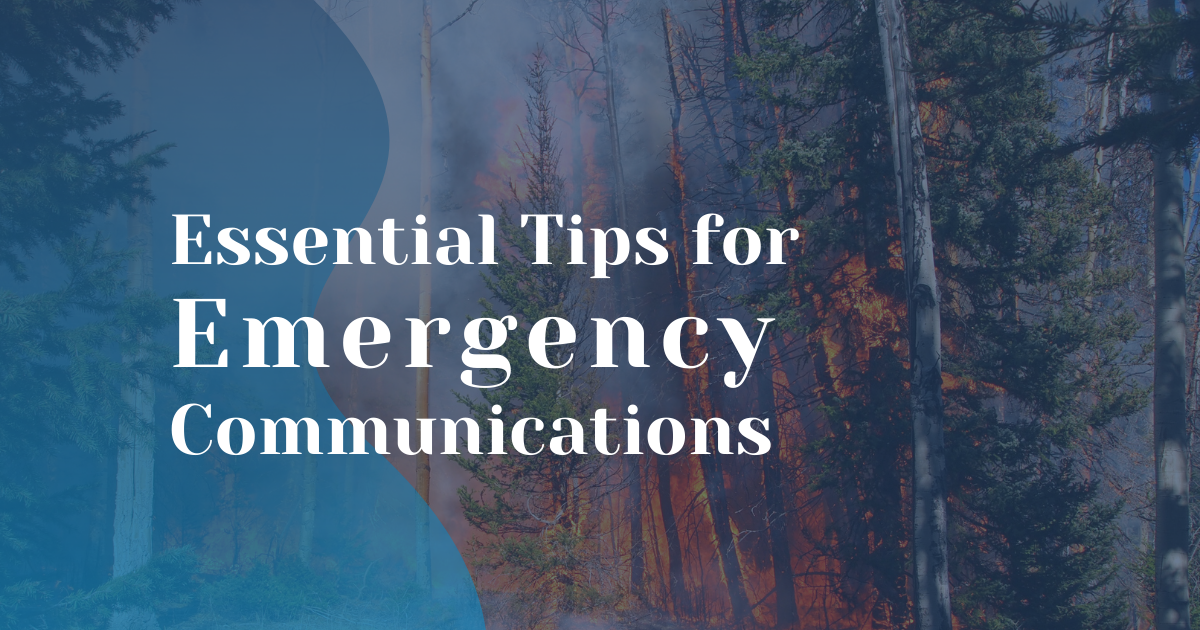Essential Tips for Emergency Communication

Recently, some of our staff have been supporting communities on the frontlines with their challenging wildfire response. These experiences have offered us valuable insights into the importance of effective emergency communication. When crises strike, clear and accurate communication is a lifeline that connects communities, instills calm, and guides critical actions. In this blog post, we’re eager to share the essential tips we’ve learned while working hand-in-hand with different client communities. We hope these insights can serve as a valuable guide for ensuring the safety and well-being of all during times of crisis.
- Develop a Comprehensive Communication Plan: Create a detailed communication plan that outlines the roles and responsibilities of community leaders, emergency responders, and communication channels during different types of emergencies. This plan should also include strategies for reaching community members with diverse needs, such as those with disabilities or language barriers.
- Establish an Official Information Source: Designate an official and reliable source of information for emergency updates, such as the community leadership, designated spokesperson, or a centralized communication team. Community members should know where to look for accurate and verified information
- Utilize Multiple Communication Channels: In emergency situations, it’s crucial to reach community members through various communication channels. With the new Meta and Google news ban that prevents Canadian news from being shared, this is more important than ever. This might include text messages, phone calls, social media, community radio, and in-person communication through community gatherings. Ensure that information is disseminated in a timely and accessible manner.
- Verify Information Before Sharing: Before sharing any information, ensure it has been verified by credible sources. Cross-reference facts with relevant authorities, emergency services, or official channels. Avoid sharing information that lacks proper verification, even if it seems urgent. If you encounter misinformation circulating within the community, address it promptly. Share accurate information through established communication channels to counteract false narratives. Calmly correct misconceptions and emphasize the importance of relying on official sources.
- Use Clear and Consistent Messaging: Craft messages that are clear, concise, and easily understood by the entire community. Avoid vague or ambiguous language that could be misinterpreted. Consistent messaging from official sources helps build trust and reduces the likelihood of misinformation taking root.
- Regular Training and Drills: Though it sounds obvious, mock scenarios and drills are easy to put off until a convenient time. But emergencies can strike at any moment. Conduct regular training sessions and emergency drills for community leaders and responders. Practice scenarios related to different types of emergencies to ensure everyone understands their roles and can effectively execute the communication plan. These drills can help identify areas for improvement and enhance overall preparedness.
- Collaborate and Build Partnerships: Foster strong relationships with neighboring communities, local authorities, and emergency services. Collaborate with these partners to share resources, information, and expertise. Having a network of support and collaboration can significantly enhance the community’s response to emergencies. Indigenous communities often deal with similar issues, meaning that solutions and best practices can also be shared.
- Respect People’s Privacy: During times of emergency, it’s essential to uphold the privacy and dignity of community members. As we communicate crucial information, be mindful not to share sensitive personal details that could compromise individuals’ privacy. When sharing stories or images, always seek consent to ensure everyone’s comfort and respect their boundaries. By prioritizing confidentiality and treating personal information with care, we not only protect community members’ rights but also cultivate a sense of trust and unity.
- Use Staff Effectively: As you prepare for potential emergencies, remember that your community is full of diverse talents and expertise. It’s paramount to figure out everyone’s roles ahead of time, ensuring a seamless response when the need arises. Identify and leverage the unique skills of your staff members to enhance your emergency response efforts. By assigning roles that align with their strengths, you can optimize your response efficiency and overall effectiveness. Foster an environment where collaboration is encouraged and every individual’s contributions are valued, allowing you to pool your talents for the greater well-being of your community.
For communities in BC, the Union of British Columbia Municipalities (UBCM) is a great source for emergency management funding. Contact your SN Advisor if you see funding you would like to pursue.